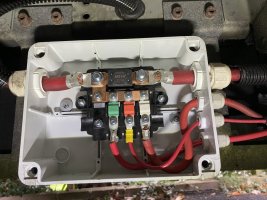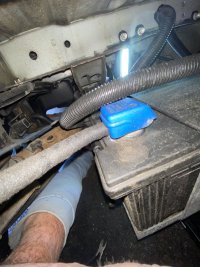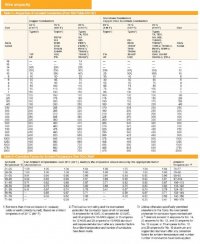On a recent long weekend away without EHU, I was dismayed to get no response from my inverter on the first morning. No tea or coffee with our breakfast (I didn’t have a backup gas burner with me - which anyway wouldn’t help with my Nespresso machine, but at least the Mrs could have had a tea). So, I spent yesterday trying to determine the cause (Hoping that it wasn’t the very expensive inverter!)
I could measure 1.06v across the inverter input terminals, but the vans volt display was showing 12.4v for my leisure battery, and the internal lights and fridge were working fine. So I guessed at a poor connection to the inverter somewhere.
Unfortunately, my electrics were all done by Exploria as part of the conversion, with the leisure battery underneath the van between the rear wheels. As a result, I had no idea how everything was wired up, but I assumed that the power leads to the inverter came direct from the battery. Having the battery under the van makes for rather awkward access, but with the rear wheels on levelling ramps and the air suspension on max height (with axle stands in place) I was able to lower the battery to discover a heavy duty +ve cable going through a 225A fuse to the inverter (all looked good, and the other electrics are also fed through this fuse) and a solitary heavy duty -ve cable being fixed to the chassis. There is no direct -ve feed to the inverter.
So, the inverter -ve must be taken from another chassis point and sure enough with a bit of searching I found it just inboard of the right rear wheel arch almost directly below where the inverter is mounted in my van. With hindsight, I didn’t need to go to all the effort of lowering the leisure battery. Hey ho.
Once I had located this -ve lead mounting point on the chassis, the cause was immediately apparent as an explosion of corrosion at the cable end, and when I unbolted the terminal from the chassis, it just fell off the cable. I’m surprised even 1v got through!
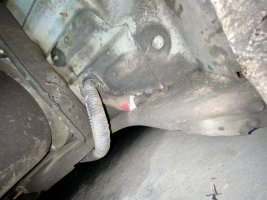
This is looking up at the inside of the right rear wheel arch and you can see how much corrosion there is (and, yes, it’s a red cable, not black as you would expect for a -ve cable).
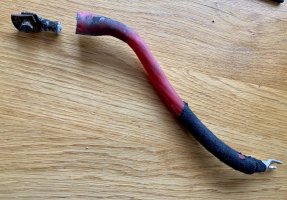
The removed cable in all it’s glory.
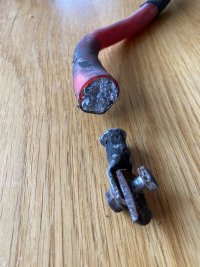
That is the worst case of vehicle cable corrosion I have ever seen, but the main leisure battery -ve to chassis cable looks fine, so why did this one corrode so badly. They were both done at the same time, less than 3 years ago.
I have ordered a replacement (black) cable, but what is the best way to prevent this happening again? Is it just a case of copious amounts of grease?
I could measure 1.06v across the inverter input terminals, but the vans volt display was showing 12.4v for my leisure battery, and the internal lights and fridge were working fine. So I guessed at a poor connection to the inverter somewhere.
Unfortunately, my electrics were all done by Exploria as part of the conversion, with the leisure battery underneath the van between the rear wheels. As a result, I had no idea how everything was wired up, but I assumed that the power leads to the inverter came direct from the battery. Having the battery under the van makes for rather awkward access, but with the rear wheels on levelling ramps and the air suspension on max height (with axle stands in place) I was able to lower the battery to discover a heavy duty +ve cable going through a 225A fuse to the inverter (all looked good, and the other electrics are also fed through this fuse) and a solitary heavy duty -ve cable being fixed to the chassis. There is no direct -ve feed to the inverter.
So, the inverter -ve must be taken from another chassis point and sure enough with a bit of searching I found it just inboard of the right rear wheel arch almost directly below where the inverter is mounted in my van. With hindsight, I didn’t need to go to all the effort of lowering the leisure battery. Hey ho.
Once I had located this -ve lead mounting point on the chassis, the cause was immediately apparent as an explosion of corrosion at the cable end, and when I unbolted the terminal from the chassis, it just fell off the cable. I’m surprised even 1v got through!

This is looking up at the inside of the right rear wheel arch and you can see how much corrosion there is (and, yes, it’s a red cable, not black as you would expect for a -ve cable).

The removed cable in all it’s glory.

That is the worst case of vehicle cable corrosion I have ever seen, but the main leisure battery -ve to chassis cable looks fine, so why did this one corrode so badly. They were both done at the same time, less than 3 years ago.
I have ordered a replacement (black) cable, but what is the best way to prevent this happening again? Is it just a case of copious amounts of grease?

